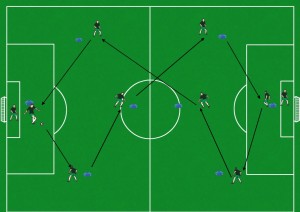How does a child learn?
It can be difficult to remember that specifically at the youth level, coaches should be focused on development of individual players – not team results. A prime part of the challenge here is the recognition that kids learn in different ways. Instruction that works for some kids may not work for others. It’s not as if people learn only one of three ways – most learn through some combination of styles. However, it’s helpful for coaches to understand the three styles so that they can adapt sessions so that all of their players have the opportunity to grasp concepts.
Let’s look at the three basic learning styles – visual, aural, and kinesthetic.
VISUAL
As you’d expect, a visual learner understands something better after seeing it. I’ve always thought it was a good idea to email youtube highlights to players every week. While a lecture is NEVER a good idea with young players, it is particularly detrimental for visual learners. In a school setting, a visual learner likes charts outlining a process…or maps…or diagramming a sentence…or videos. Diagramming patterns of play and/or positions provides cues which are helpful.
During a pre game warmup with a group of u10s I used a passing pattern to reinforce concepts such as receiving with the back foot, and receiving on the half turn:
From a technical perspective, it was a success. After it was over, I drew our team’s typical formation on the clipboard, verbally reinforced passing options out of the back, through the midfield, and to the forward – while drawing the lines between the players (something every coach has done a million times). On this occasion, as I drew the lines one player clearly had a “eureka” moment. He finally connected the dots (pun intended), and during the game it was clear that he “got it.” Obviously, he was a visual learner.
AURAL
People with an auditory learning style remember things after hearing them. They often need to repeat what they’ve learned out loud and prefer verbal repetition. They also like to talk a lot! In school, they may need to read aloud to themselves. During training, it may be helpful to change how you phrase a question about something so that it’s easier for a player to understand. Like with all training, it’s vital to figure out how to get the player to think creatively for themselves. Rephrasing a question and ensuring the kid answers through repetition may provide a solution. If an auditory learner doesn’t understand something, it may be helpful to further engage with him so that he talks about it in more detail.
KINESTHETIC
Kinesthetic learners best learn by doing; physical repetition is essential. Long lectures will be forgotten; these learners remember what they did, not what they saw or heard. Situational experiences will reinforce concepts. In soccer terms, repetition of specific motor skills as well as the use of realistic practice games that recreate problems for them to solve works well. It’s great to play a possession game; it’s better if it’s played in a particular area of the field – or going to goal – so that the players understand positional roles.
Players learn things in their own way, in their own time. The coach’s task is to guide players through the learning process, and this can be made easier by understanding the best way to work with them.
